Shrubs of the Adirondacks:
Bog Rosemary (Andromeda polifolia)
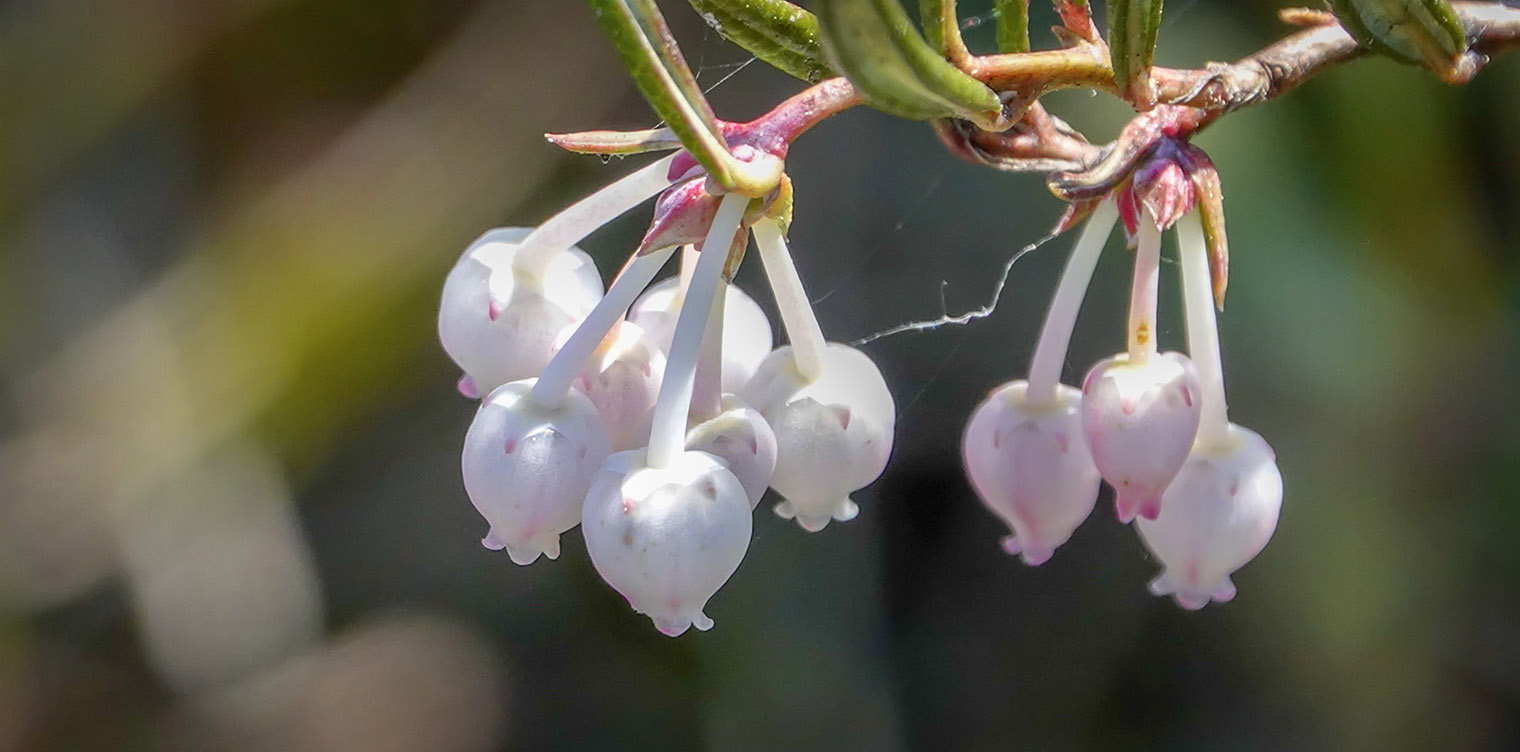
Bog Rosemary (Andromeda polifolia) is a small, native evergreen shrub with blue-gray foliage which produces small pinkish flowers in spring. It grows in bogs in the Adirondack Mountains of upstate New York.
Bog Rosemary is a member of the Heath family. The common name of this plant reflects the fact that its leaves are similar to those of common garden Rosemary, although the two plants are totally unrelated. This plant is also known as Wild Rosemary.
Bog Rosemary was given its Latin name by Linnaeus, who compared it with the goddess Andromeda; Andromeda was chained to a rock in the sea, while the Bog Rosemary is fixed to the middle of wetlands.
Identification of Bog Rosemary
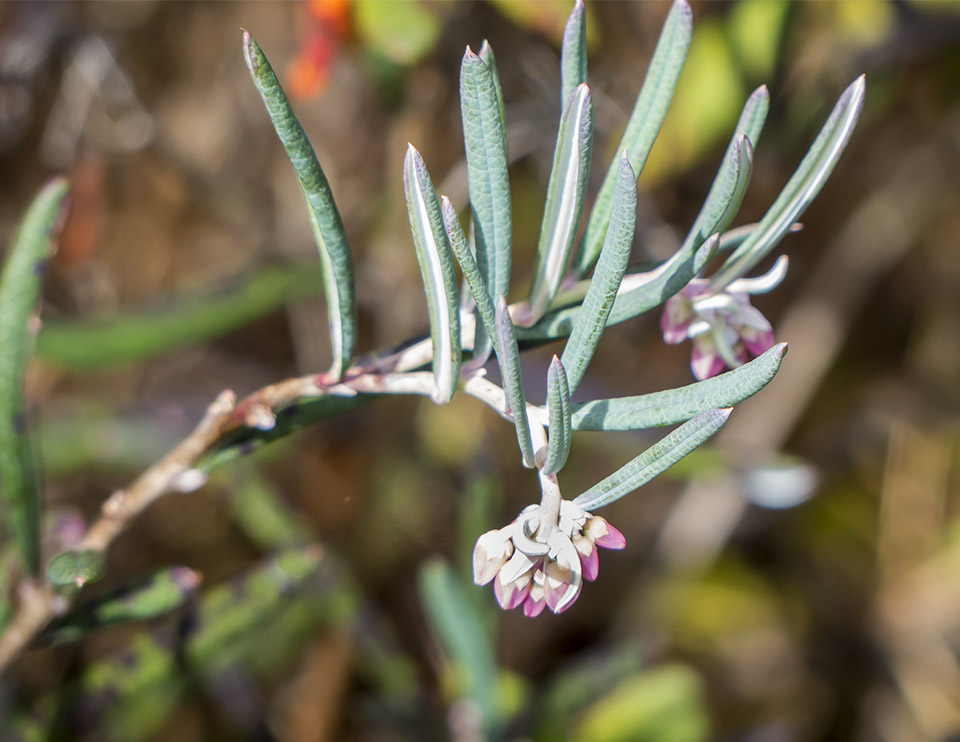
Bog Rosemary is one of several leathery-leafed plants growing in swampy or boggy habitats. It grows up to two feet tall.
Bog Rosemary's slender, dark green evergreen leaves are 2 inches long and about a quarter of an inch wide. The leaf marginsThe structure of the leaf's edge. are smooth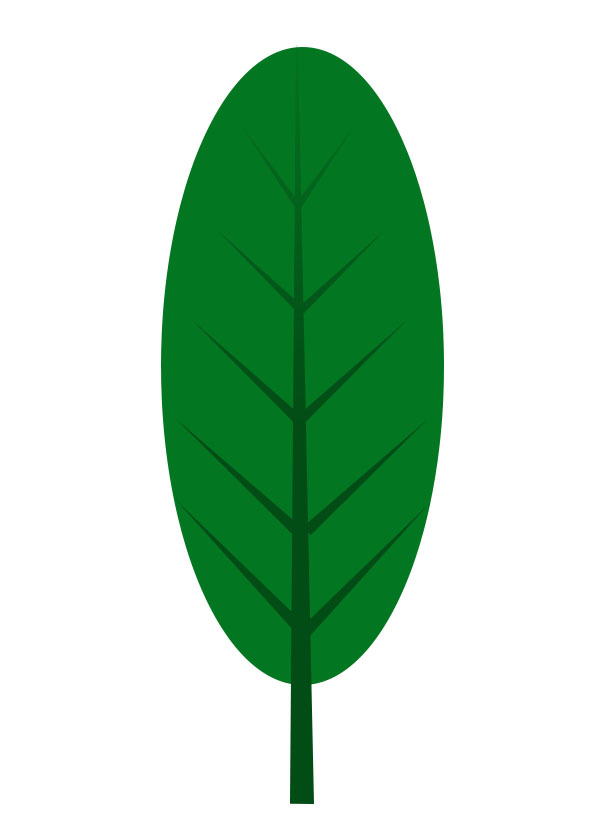 Smooth leaf edges do not have any teeth., meaning that the edge of the leaves do not have teeth. The leaves are alternate
Smooth leaf edges do not have any teeth., meaning that the edge of the leaves do not have teeth. The leaves are alternate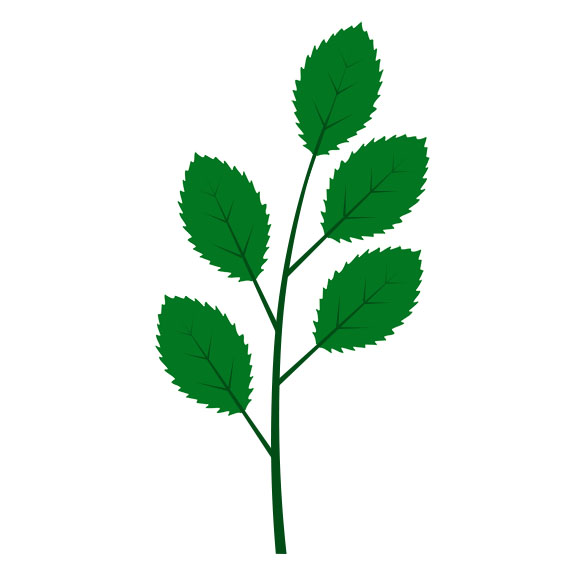 Alternate: An arrangement of leaves (or buds) on a stem (or twig) in which the leaves emerge from the stem one at a time. This often makes the leaves appear to alternate on the stem.; that is, the leaves merge from the stem one at a time. The leaves roll inwards. The underside of the leaves is whitened by tiny hairs.
Alternate: An arrangement of leaves (or buds) on a stem (or twig) in which the leaves emerge from the stem one at a time. This often makes the leaves appear to alternate on the stem.; that is, the leaves merge from the stem one at a time. The leaves roll inwards. The underside of the leaves is whitened by tiny hairs.
The plant has small terminal clusters of bell-shaped, nodding flowers, which appear in mid-spring. In the Adirondack region, Bog Rosemary usually starts to bud in mid- or late-May, and flowers in late May to early June. Each flower is about a quarter of an inch long. The flowers are usually pale pink, but can also be white.
The fruit of Bog Rosemary is a dry, rounded capsule. In the Adirondack region, the fruit has begun development by early July. The fruit is a round, pink segmented capsule with five segments containing many seeds. The remains of the pistil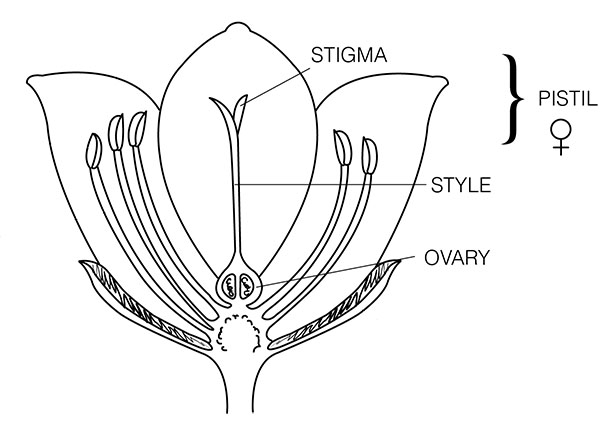 The female part of the flower made up of the stigma, style, and ovary. persists at the top of each capsule. As the fruit matures, it turns brown and eventually splits, releasing the seeds.
The female part of the flower made up of the stigma, style, and ovary. persists at the top of each capsule. As the fruit matures, it turns brown and eventually splits, releasing the seeds.
One key to identifying Bog Rosemary and differentiating it from other leathery-leafed plants growing in swampy or boggy habitats is the leaf arrangement.
- Sheep Laurel and Bog Laurel both have opposite leaves
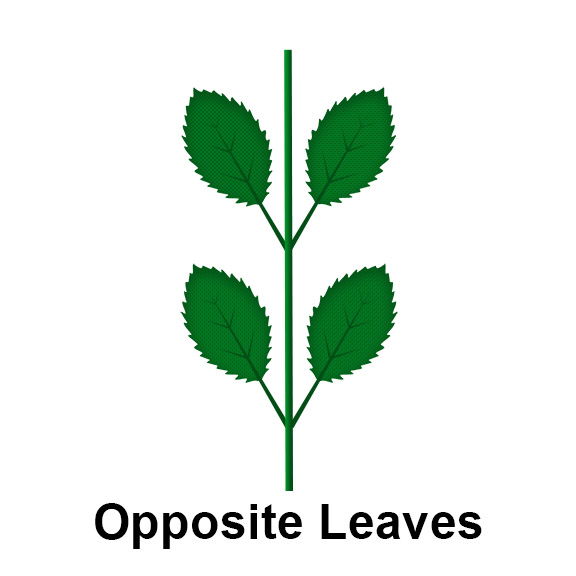 Opposite Leaves: Leaves occurring in pairs at a node, with one leaf on either side of the stem., in contrast to Bog Rosemary, which has alternate leaves
Opposite Leaves: Leaves occurring in pairs at a node, with one leaf on either side of the stem., in contrast to Bog Rosemary, which has alternate leaves Alternate: An arrangement of leaves (or buds) on a stem (or twig) in which the leaves emerge from the stem one at a time. This often makes the leaves appear to alternate on the stem..
Alternate: An arrangement of leaves (or buds) on a stem (or twig) in which the leaves emerge from the stem one at a time. This often makes the leaves appear to alternate on the stem.. - Like Bog Rosemary, Leatherleaf and Labrador Tea have alternate leaves. However, the leaf margins of the Leatherleaf are not inrolled, and the undersides of the leaves have yellow, waxy deposits. Labrador Tea has much wider leaves with rusty to whitish undersides and hairy twigs.
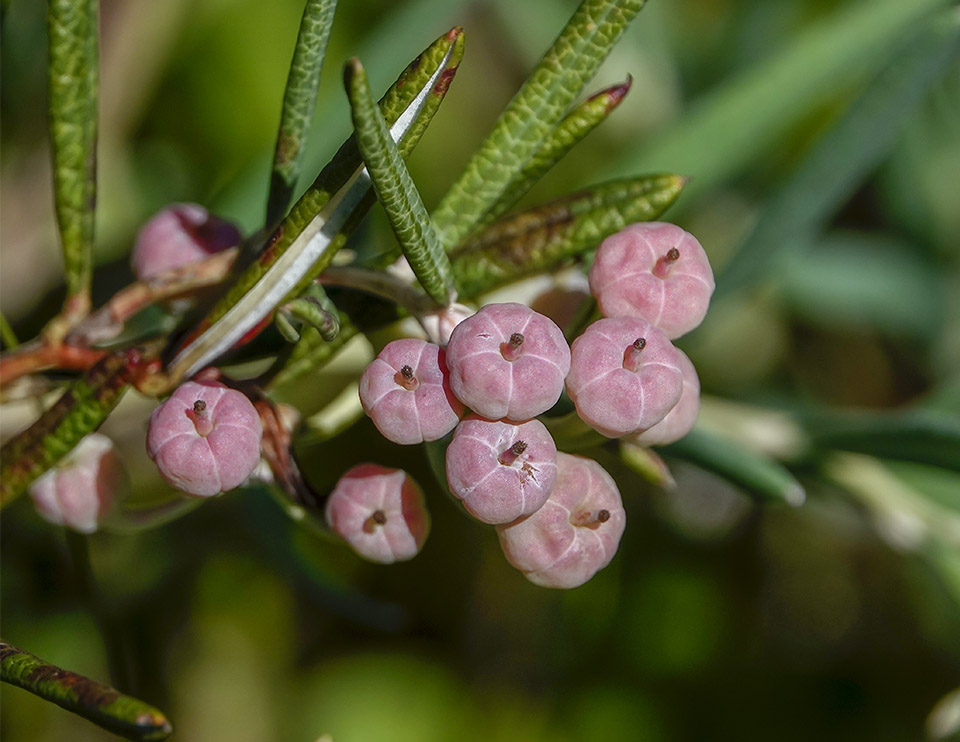
Bog Rosemary flowers are also a useful identification key, since they are distinct from those of other evergreen shrubs which flourish in bogs.
- Bog Rosemary flowers are bell-shaped, like those of Leatherleaf, but are arrayed on the plant in a completely different way. The white Leatherleaf bells appear on axils of the current year's leaves, forming a one-side raceme
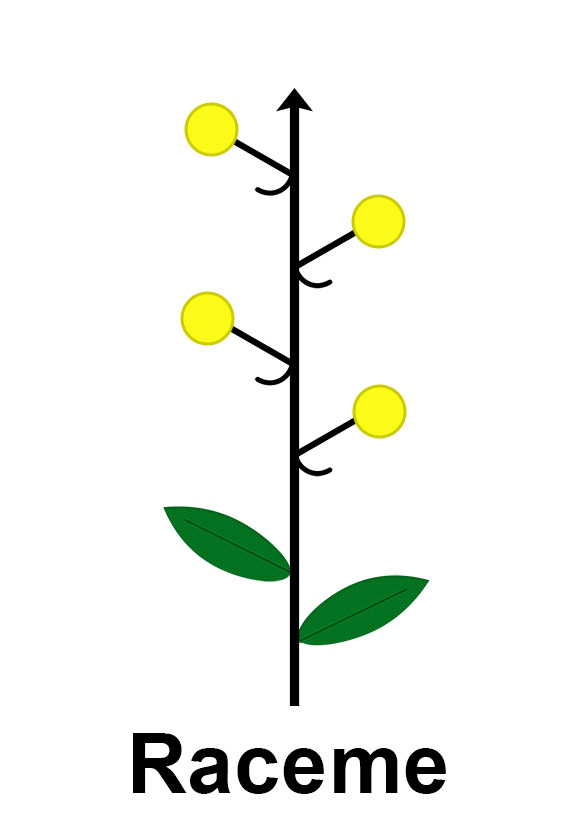 Raceme: A flower cluster with the separate flowers attached by short equal stalks at equal distances along a central stem. , while the pinkish Bog Rosemary flowers appear in clusters at the end of the branch.
Raceme: A flower cluster with the separate flowers attached by short equal stalks at equal distances along a central stem. , while the pinkish Bog Rosemary flowers appear in clusters at the end of the branch. - Bog Laurel flowers also appear to be on the end of the branch. However, the flowers are a much darker rose-purple and are not in the shape of a bell.
- Sheep Laurel flowers appear in lateral clusters grouped near the previous year's leaves; that is, the leaves appear farther down on the branch, with new leaf growth above.
Uses of Bog Rosemary
Although some Native American Indian tribes reportedly used the fresh or dried leaves of Bog Rosemary for a tea, all parts of the plant are said to be toxic in large quantities. No parts of it should be eaten. Symptoms of poisoning include watering of the mouth, eyes, and nose; loss of energy; slow pulse; vomiting; low blood pressure; lack of coordination; convulsion; and progressive paralysis.
Wildlife Value of Bog Rosemary
Bog Rosemary has limited importance to wildlife. The plant contains a poisonous substance and has been known to kill domestic sheep that attempt to browse on it. However, the bog communities where Bog Rosemary flourishes are extremely important to some bird species, including the Palm Warbler and Lincoln's Sparrow.
Distribution of Bog Rosemary
Bog Rosemary is found in the northeastern regions of the US. This species occurs from Greenland westward through all of the Canadian provinces to Alaska and south to Washington and Idaho. It occurs south along the north Atlantic coast to New Jersey and west to Illinois and Minnesota
Bog Rosemary occurs in most New York State counties. It has been reported in all of the counties in the Adirondack Park Blue Line, with the exception of Saratoga County.
Habitat of Bog Rosemary
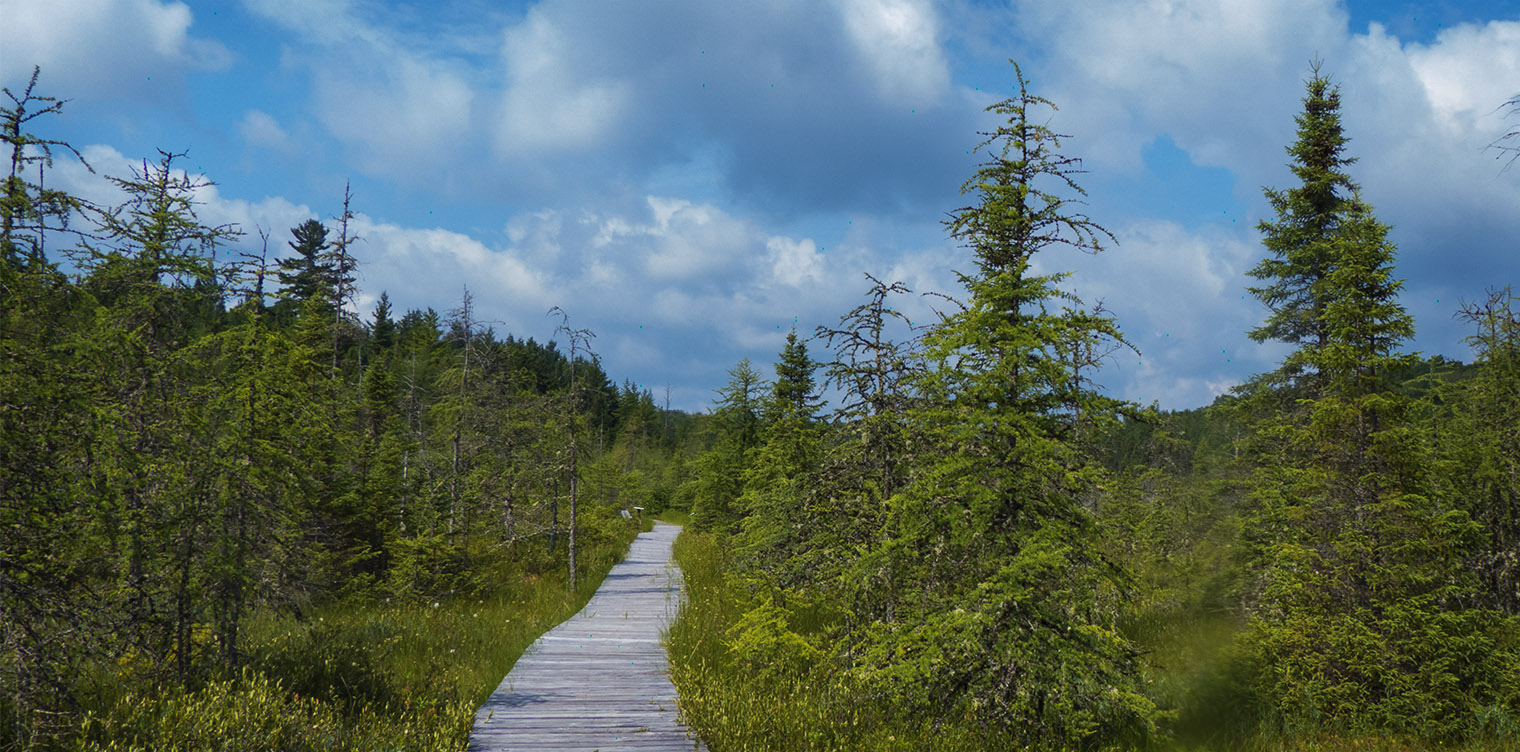
Bog Rosemary is a wetland species which usually occurs in poorly drained soils. It classified as an "obligate wetland" plant, which means that it almost always occurs in wetlands. It typically is found on sites with wet peat moss.
In the Adirondacks, Bog Rosemary is found in several ecological communities, including:
Look for Bog Rosemary along trails that go through acidic bogs:
- This shrub typically grows near small, scrubby specimens of Black Spruce and Tamarack.
- Bog Rosemary grows alongside other bog-dwelling evergreen shrubs, including Labrador Tea, Bog Laurel, and Sheep Laurel.
- Wildflowers that flourish in this habitat include Cottongrass, Pitcher Plant, Grass Pink, Rose Pogonia, Buckbean, and Marsh Cinquefoil.
- Birds found in this habitat include the Palm Warbler, Lincoln's Sparrow, and Yellow-bellied Flycatcher.
The most convenient place to observe Bog Rosemary is along the Boreal Life Trail boardwalk across Barnum Bog.
References
Michael Kudish. Adirondack Upland Flora: An Ecological Perspective (Saranac, New York: The Chauncy Press, 1992), pp. 141-142.
New York Flora Association. New York Flora Atlas. Bog-rosemary. Andromeda polifolia L. var. latifolia Aiton. Retrieved 14 March 2017.
United States Department of Agriculture. The Plants Database. Andromeda polifolia L. Bog Rosemary. Retrieved 14 March 2017.
United States Department of Agriculture. Fire Effects Information System (FEIS). Species Reviews. Andromeda polifolia. Retrieved 14 March 2017.
Flora of NorthAmerica. Andromeda polifolia Linnaeus var. latifolia Aiton. Retrieved 14 March 2017.
Lady Bird Johnson Wildflower Center. Native Plant Database. Retrieved 14 March 2017.
Northern Forest Atlas. Images. Bog Rosemary. Retrieved 13 November 2021.
Jerry Jenkins. Woody Plants of the Northern Forest. A Digital Atlas. (The Northern Forest Atlas Project, April 2020), p. 178. Retrieved 13 November 2021.
New York State. Adirondack Park Agency. Preliminary List of Species Native Within the Adirondack Park Listed Alphabetically by Scientific Name and Sorted by Habit. Volume 1. Updated 10.23.2006, p. 9. Retrieved 26 January 2017.
New York Natural Heritage Program. 2021. Online Conservation Guide for Dwarf Shrub Bog. Retrieved 13 November 2021.
New York Natural Heritage Program. 2021. Online Conservation Guide for Inland Poor Fen. Retrieved 13 November 2021.
New York Natural Heritage Program. 2021. Online Conservation Guide for Medium Fen. Retrieved 13 November 2021.
New York Natural Heritage Program. 2021. Online Conservation Guide for Patterned Peatland. Retrieved 13 November 2021.
iNaturalist. Wild Rosemary. Andromeda polifolia. Retrieved 13 November 2021.
iNaturalist. Adirondack Park Observations. Wild Rosemary. Andromeda polifolia. Retrieved 13 November 2021.
University of Michigan. Native American Ethnobotany. A Database of Foods, Drugs, Dyes and Fibers of Native American Peoples, Derived from Plants. Andromeda polifolia L. Bog Rosemary. Retrieved 14 March 2017.
NatureServe Explorer. Online Encyclopedia of Life. Retrieved 29 March 2015.
Plants for a Future. Database. Retrieved 29 March 2015.
University of Wisconsin. Flora of Wisconsin. Retrieved 29 March 2015.
University of Wisconsin. Shrubs of Wisconsin. Retrieved 29 March 2015.
Connecticut Wildflowers. Wildflower Guide. Retrieved 29 March 2015.
John Eastman. The Book of Swamp and Bog: Trees, Shrubs, and Wildflowers of Eastern Freshwater Wetlands (Stackpole Books, 1995), pp. 25-27.
The Cornell Lab of Ornithology. Birds of North America. Yellow-bellied Flycatcher. Subscription web site. Retrieved 14 March 2017.
Allen J. Combes. Dictionary of Plant Names (Timber Press, 1994), p. 11.
Minnesota Wildflowers. Database. Retrieved 29 March 2015.
Native Plant Trust. Andromeda polifolia. Retrieved 23 December 2019.
Birds of the Boreal Life Trail. Barnum Bog Birds. VIC Birding Trail Guide (June 2015).
Doug Ladd. North Woods Wildflowers (Falcon Publishing, 2001), p. 73.
Lawrence Newcomb. Newcomb's Wildflower Guide (Little Brown and Company, 1977), pp. 292-293.
Meiyin Wu and Dennis Kalma. Wetland Plants of the Adirondacks. Ferns, Woody Plants, and Graminoids (Trafford Publishing, 2010), pp. 39, 61, 62.
Charles W. Johnson. Bogs of the Northeast (Hanover, New Hampshire: University Press of New England, 1985), p. 29.
Donald D. Cox. A Naturalist's Guide to Wetland Plants. An Ecology for Eastern North America (Syracuse University Press, 2002), pp. 83-84, 90.
John Eastman. The Book of Swamp and Bog. Trees, Shrubs, and Wildflowers of Eastern Freshwater Wetlands (Mechanicsburg, PA: Stackpole Books, 1995), pp. 25-26.
David M. Brandenburg. Field Guide to Wildflowers of North America (New York, NY: Sterling Publishing Company, Inc., 2010), p. 215.
George A. Petrides. A Field Guide to Trees and Shrubs (Boston: Houghton Mifflin Company, 1958, 1972), pp. 288, 364-365.
Janet Lyons and Sandra Jordon. Walking the Wetlands. A Hiker's Guide to Common Plants and Animals of Marshes, Bogs, and Swamps (New York, NY: John Wiley & Sons, Inc., 1989), pp. 91-92.
Ronald B. Davis. Bogs & Fens. A Guide to the Peatland Plants of the Northeastern United States and Adjacent Canada (University Press of New England, 2016), 114-115.
